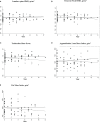Abnormal Trabecular Bone Score, Lower Bone Mineral Density and Lean Mass in Young Women With Premature Ovarian Insufficiency Are Prevented by Oestrogen Replacement
- PMID: 35663323
- PMCID: PMC9162038
- DOI: 10.3389/fendo.2022.860853
Abnormal Trabecular Bone Score, Lower Bone Mineral Density and Lean Mass in Young Women With Premature Ovarian Insufficiency Are Prevented by Oestrogen Replacement
Abstract
Background: Low bone density (BMD) and fractures commonly affect women with premature ovarian insufficiency (POI). However, bone microarchitecture and body composition data are lacking.
Objective: To assess and characterise musculoskeletal phenotype and effects of oestrogen replacement therapy (ERT) in women with POI.
Method: Cross-sectional and longitudinal studies of 60 normal karyotype women with POI, aged 20-40 years, from 2005-2018. Dual x-ray absorptiometry (DXA)-derived spinal (LS) and femoral neck (FN) BMD, trabecular bone score (TBS), appendicular lean mass (ALM), total fat mass (TFM), and fracture prevalence were compared with 60 age-, and BMI-matched population-based controls. Longitudinal changes in bone and body composition variables and ERT effects were analysed using linear mixed models over a median duration of 6 years.
Results: Women with POI were subdivided into spontaneous (s)-POI (n=25) and iatrogenic (i)-POI (n=35). Median(range) age of POI diagnosis was 34 (10-40) years with baseline DXA performed at median 1(0-13) year post-diagnosis. ERT was used by 82% women (similar for both POI groups). FN-BMD were lowest in s-POI (p<0.002). Low TBS was more common in s-POI [(44%), p=0.03], versus other groups. LS-BMD and ALM were lower in both s-POI and i-POI groups than controls (p<0.05). Fracture prevalence was not significantly different: 20% (s-POI), 17% (i-POI), and 8% (controls) (p=0.26). Longitudinal analysis of 23 POI women showed regular ERT was associated with ALM increment of 127.05 g/year (p<0.001) and protected against bone loss. However, ERT interruption was associated with annual reductions in FN BMD and TBS of 0.020g/cm2 and 0.0070 (p<0.05), respectively.
Conclusion: Deficits in BMD, trabecular microarchitecture, and lean mass were present in women with POI. However, regular ERT protected against declines in bone variables, with an increase in ALM. Assessment of skeletal and muscle health, and advocating ERT adherence, is essential in POI to optimise musculoskeletal outcomes.
Keywords: appendicular lean mass; body composition; bone mineral density; osteoporosis; premature ovarian insufficiency; trabecular bone score.
Copyright © 2022 Samad, Nguyen, Hashimura, Pasco, Kotowicz, Strauss, Ebeling, Milat and Vincent.
Conflict of interest statement
The authors declare that the research was conducted in the absence of any commercial or financial relationships that could be construed as a potential conflict of interest.
Figures



Similar articles
-
Bone mineral density, vertebral fractures and trabecular bone score in primary ovarian insufficiency.J Endocrinol Invest. 2023 Sep;46(9):1865-1874. doi: 10.1007/s40618-023-02045-z. Epub 2023 Feb 27. J Endocrinol Invest. 2023. PMID: 36848018
-
Femora of women with premature ovarian insufficiency exhibit reduced strength and misalignment with the transmitted vertical forces from the upper body.Eur J Endocrinol. 2024 Feb 1;190(2):182-191. doi: 10.1093/ejendo/lvad158. Eur J Endocrinol. 2024. PMID: 38064575
-
Bone health in women with premature ovarian insufficiency/early menopause: a 23-year longitudinal analysis.Hum Reprod. 2024 May 2;39(5):1013-1022. doi: 10.1093/humrep/deae037. Hum Reprod. 2024. PMID: 38396142 Free PMC article.
-
Musculoskeletal Health in Premature Ovarian Insufficiency. Part Two: Bone.Semin Reprod Med. 2020 Sep;38(4-05):289-301. doi: 10.1055/s-0041-1722849. Epub 2021 Mar 30. Semin Reprod Med. 2020. PMID: 33784746 Review.
-
Use of Trabecular Bone Score (TBS) as a Complementary Approach to Dual-energy X-ray Absorptiometry (DXA) for Fracture Risk Assessment in Clinical Practice.J Clin Densitom. 2017 Jul-Sep;20(3):334-345. doi: 10.1016/j.jocd.2017.06.019. Epub 2017 Jul 19. J Clin Densitom. 2017. PMID: 28734710 Review.
Cited by
-
'Bone Health-Across a Woman's Lifespan'.Clin Endocrinol (Oxf). 2025 Apr;102(4):389-402. doi: 10.1111/cen.15203. Epub 2025 Jan 27. Clin Endocrinol (Oxf). 2025. PMID: 39871618 Free PMC article. Review.
-
Primary ovarian insufficiency: update on clinical and genetic findings.Front Endocrinol (Lausanne). 2024 Sep 26;15:1464803. doi: 10.3389/fendo.2024.1464803. eCollection 2024. Front Endocrinol (Lausanne). 2024. PMID: 39391877 Free PMC article. Review.
-
Bone mineral density, vertebral fractures and trabecular bone score in primary ovarian insufficiency.J Endocrinol Invest. 2023 Sep;46(9):1865-1874. doi: 10.1007/s40618-023-02045-z. Epub 2023 Feb 27. J Endocrinol Invest. 2023. PMID: 36848018
-
Osteoporosis and bone metabolism in patients with Klinefelter syndrome.Endocr Connect. 2023 Jul 5;12(8):e230058. doi: 10.1530/EC-23-0058. Endocr Connect. 2023. PMID: 37166398 Free PMC article. Review.
-
17β-Estradiol Effects in Skeletal Muscle: A 31P MR Spectroscopic Imaging (MRSI) Study of Young Females during Early Follicular (EF) and Peri-Ovulation (PO) Phases.Diagnostics (Basel). 2024 Jan 23;14(3):235. doi: 10.3390/diagnostics14030235. Diagnostics (Basel). 2024. PMID: 38337751 Free PMC article.
References
MeSH terms
LinkOut - more resources
Full Text Sources
Medical
Miscellaneous

